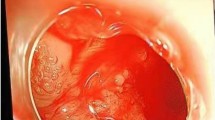Abstract
In view is a 35-year-old male patient, evaluated in the emergency room with hypovolemic shock, hematemesis and melena. By gastroscopy an duodenal ulcer located in the posterior aspect of the 1st portion of duodenum was found, being treated by adrenaline injections and clips. The bleeding could not be controlled and patient was operated on. By laparotomy hemostatic sutures were placed around the ulcer. Postoperatively important duodenal bleeding recurred.
Access provided by Autonomous University of Puebla. Download chapter PDF
Similar content being viewed by others
Keywords
Diagnosis and Indication for Surgery
In view is a 35-year-old male patient, evaluated in the emergency room with hematemesis and melena. The patient possessed a history of smoking, a duodenal ulcer treated irregularly with proton pump inhibitors (PPIs), and a positive Helicobacter pylori breathing test with irregular treatment. He was also taking Diclophenac® 75 mg orally for 2 days due to a traumatic lesion of the right leg. At examination, the patient was in shock with signs of hypoperfusion, with a blood pressure of 90/40 mmHg and a heart rate of 110/min.
Two peripheral intravenous 14F lines were placed in his upper limbs. The hemoglobin was 7 g/dL, platelets were 350,000, and coagulation times in normal range. Two packed cell blood concentrates were transfused.
Gastroscopy summarily showed an ulcer of 2.5 cm in the posterior side of the first portion of the duodenum, classified as Forrest IIb (bleeding with visible vessel) (Fig. 14.1). Adrenaline was infiltrated together with contact diathermia therapy and the bleeding stopped. The patient was admitted to the ICU and received 80 mg Omeprazol® intravenously as a bolus and as a continuous perfusion afterwards. The Helicobacter pylori test was positive.
Four hours after the first procedure, the patient complained about abdominal pain, hematemesis, and hypotension. A second endoscopic procedure was performed with evidence of active bleeding in the ulcer; the bleeding could not be controlled with adrenaline and clips.
Operation
Due to his hemodynamic instability and failure of the endoscopic treatment, surgery was indicated. A medial laparotomy was done, followed by a Kocher maneuver, a longitudinal duodenostomy at the level of the pylorus, and identification of the ulcer. Hemostatic sutures were placed in the four quadrants of the ulcer with Prolene 3/0®. The bleeding was controlled. Peroperatively, the patient remained hypotensive, requiring inotropes and transfusion of eight packed cell units. The duodenotomy was closed in one layer with PDS 4/0. A nasogastric tube was placed in the antrum, and he was readmitted to the ICU.
Postoperative Course
Twenty-four hours after surgery, hematemesis and hypotension recurred with a hemoglobin of 7 g/dL. Blood and clots were removed by flushing saline through the nasogastric tube. A new gastroscopy showed a recurrent ulcer bleeding; so again clips were placed and bleeding partially became controlled. Additionally, an angiography was performed, showing a bleeding from the gastroduodenal artery with a blush (Fig. 14.2) and consequently an embolization with coils was performed (Fig. 14.3).
The patient evolved favorably leading to discharge at the 8th postoperative day with Helicobacter pylori eradication therapy for 2 weeks. A second Helicobacter pylori breath test was negative.
Discussion
Acute bleeding is the most common complication of peptic ulcer disease and its mortality lies between 5 and 10 %. Endoscopic treatment solves bleeding in the majority of patients; however 5–10 % of patients have re-bleeding and require surgery or embolization (Illustration 14.1a, b). After surgery, the risk of re-bleeding is about 4 %. The factors that increase the risk of re-bleeding are: an ulcer larger than 2 cm, localized in the lesser curvature or posterior side of the duodenal bulb, and hypovolemic shock.
Author information
Authors and Affiliations
Corresponding author
Editor information
Editors and Affiliations
Rights and permissions
Copyright information
© 2014 Springer International Publishing Switzerland
About this chapter
Cite this chapter
Sabrido, J.L.G., Jimenez, W.V. (2014). Case on Re-bleeding After Repair of Bleeding Duodenal Ulcer. In: Cuesta, M., Bonjer, H. (eds) Case Studies of Postoperative Complications after Digestive Surgery. Springer, Cham. https://doi.org/10.1007/978-3-319-01613-9_14
Download citation
DOI: https://doi.org/10.1007/978-3-319-01613-9_14
Published:
Publisher Name: Springer, Cham
Print ISBN: 978-3-319-01612-2
Online ISBN: 978-3-319-01613-9
eBook Packages: MedicineMedicine (R0)








